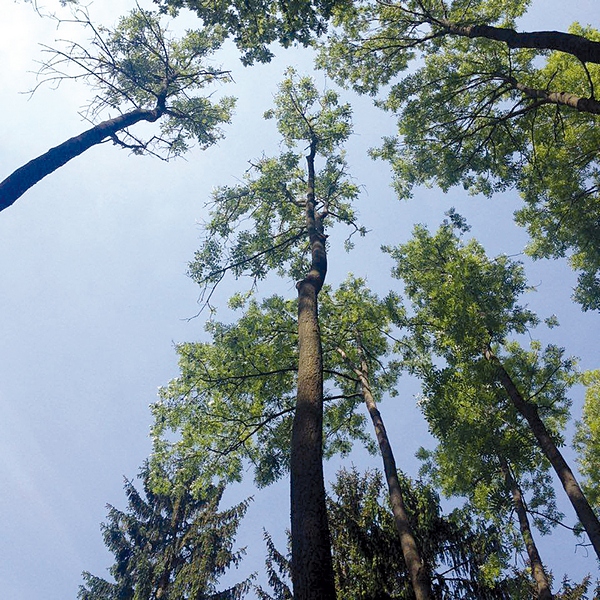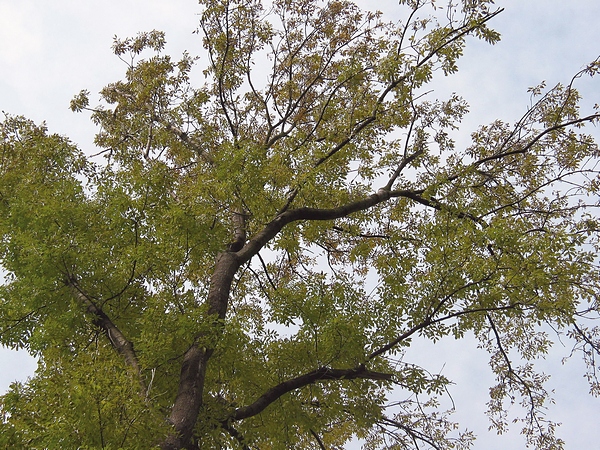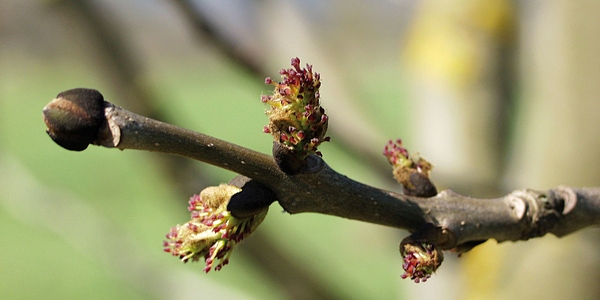
Figure 1: Different intensities of dieback in a monitoring site of BFW (Siegenfeld, Lower Austria). Fotocredit: A. Wohlmuth
The Fraxinus species are of considerable importance in Europe and are amongst the most valuable broad-leaved timber species. In Austria, it occurs widely in different ecological regions. Until ten years ago, planting of Ash trees was highly encouraged, as it proved to be a suitable replacement of conifer stands in lowland areas. But now, large parts of European forests have been affected by Fraxinus /Ash-dieback caused by a ascomycetes fungus Hymenoscyphus fraxineus.
This is an emerging disease, which resulted in massive tree mortality, threatening the existence of Fraxinus spp. throughout the continent. So what can be learned from the prevention strategies in the countries where this disease has long been ravaging countless forests? And what are the measures taken in the south of Europe to protect the trees from this newly experienced fungal infection?
FRAXBACK (Fraxinus dieback in Europe), a network of European researchers, has been working intensively over the last four years to find a solution to tackle this issue. This network was established under the auspices of COST (European Cooperation in Science & Technology) and became a platform where researchers from all over Europe and overseas shared their experiences from completed or ongoing research projects on Ash-dieback all over the continent.
At the first meeting in Vilnius (Lithuania) in a dramatic turn of events, reporters from BBC almost "besieged" the meeting hall with news of the then "invasion of the continent", as the first occurrence of the pathogen in the Continent was discovered in the British Isles.
It was 20 years ago that the effects of Ash-dieback were informed in the north-east of Poland. The neighboring Baltic states have already gathered long term experience on the effects of this infection So when by 2007, the disease first became apparent in the Austrian forests (Heinze et al., 2017), attention was already drawn to this problem in the research world. The pathogenicity of H. fraxineus on Fraxinus excelsior or Common Ash was confirmed in wound inoculation experiments, thus proving the former as the causal agent of Ash dieback.
For example, there was a sharp decline in sales of plants and subsequent decrease in the amount of harvested seeds was noted. Thus, Austrian researchers at the University of Soil Culture led by Dr. Thomas Kirisits and the BFW represented by Dr. Thomas Cech had already embarked on an intensive research on the disease.
The transmission of the fungal spores
Due to the lack of any pathological history or presence of any accurate disease traces and comprehensive observations, the pathogen can only be experimentally reconstructed on the basis of indirect indications. The geographic origin is still somewhat obscure, as the enclave of Kaliningrad (Koenigsberg), which is bordering on northeast Poland, has not yet been opened for research. In any case, the disease was thought to be brought to Europe from East Asia.
The different species of Fraxinus like Manchurian Ash (Fraxinus mandshurica) is found in China (up to about 1,000 km southeast of Beijing), North Korea, in the far east of Russia (Vladivostok) as well as in Japan. But it hardly forms pure populations there and there is still no clarity on how great the influence of the pathogen on this natural host tree species is? In China, there are no conspicuous fungi, although Ash is used intensively there.
How this pathogen traveled from East Asia (no data of exact geographical area) to Europe is as unclear as about the timing of this transfer. In addition, the southern Baltic region is not the focal point of international trade routes as ports are often the starting points of "biological invasions". In any case, a link between the two Russian ports of Vladivostok and Kaliningrad would be conceivable, but presently it is pure speculation.
The harmful fungus Hymenscyphus fraxineus (syn. Chalara fraxinea) is typically mesophilic, enjoys moderate temperatures and like most other fungi survives on high humidity. This indicates that the oceanic climate at the place of origin, as is the case of Japan and around Vladivostok (while some Chinese origins of the Manchurian Ash are characterized by a partly continental climatic climate) was appropriate for its growth. In the Baltics, it seems to have felt very comfortable and, at first unintentionally, spread out on the not very frequent Ash. It is unlikely that a single specimen of the Manchurian Ash, planted in nearby Estonia, was planted.
The Wind as a probable agent

Figure 2: Also the narrow-leafed ash (Fraxinus angustifolia) is affected by Ash-dieback. Foto copyright: B. Heinze, BFW
As with many species, which are concerned with such "invasion", the genetic diversity in Europe is conspicuously restricted to this harmful fungus (a new combination by sexual propagation cycles still exists). The spreading probably took place successively with the wind; The spores are thus likely to have traveled the distance to England in 20 years (even against prevailing wind directions in Europe).
In 2002 there were some first time reports of this pathogen from the Czech Republic. Denmark and Northern Germany were affected relatively early. Since there are many nurseries spread across Europe, it is thought whether plant transports (such as in Austria) have accelerated the spread of the disease (Heinze et al., 2017).
The northern Mediterranean region has been largely spared of this attack, as are continental regions of the Pannonian Basin with no reports of this pathogenic invasion. But in the last few years, however, a further advancement of the disease was observed, as in Tuscany. Although the dry, hot climate generally not suitable for the growth of this fungus, the Ash is still bound to fresh and humid soils, and this local climate, for example in large floodplains on the lowland rivers, has a beneficial effect on the pathogen.
Pathogenic invasion in Austria
In Austria the symptoms of the disease were first reported in 2005. Since the importance of the disease was not yet fully understood as systematic observations were not made from the very onset. However, BFW soon started a monitoring program in 2007 and is still being continued (Dr. Thomas Cech, Figure 1).
From the main spreading area of the Ash, in the lowlands and in the edge of the Alps, the disease spread rapidly and reached the inner alpine valleys after only a few years (for example, East-Tirol no later than 2010). At the beginning of the monitoring, the course of the disease did not progress very rapidly, year by year; Rather dry-continental sites were less affected.
Sporulation and spore germination is favored by moist conditions. The progress of the disease, however, was greater, especially in more precipitous summers. Interestingly, the years 2005-2010 and 2012-2013 show above-average summer rainfall for, for example, St. Pölten (Heinze et al., 2017). Hot, dry summers do not like the fungus (growth is over 30 degrees Celsius); In such years the trees can recover somewhat (but do not completely overcome the disease).
Nevertheless, a further intensification of the disease has been observed especially in recent years (since about 2011). Where observations on certain trees were repeated more frequently (as in seed plants or in some forestry companies, Heinze et al., 2017), the dying of trees was soon noticed. In the off-shore area, trunk necroses occurred, and trees had to be cut in order to prevent pathways (in cases of sick trees, care should be taken, since dead branches can fall).
The root necrosis is one of the main problems in other countries (for example, Belgium or Baden-Württemberg in Germany) causing tree mortality. It has been observed across Europe, that younger trees are more severely affected than the older ones. Studies on the infection of younger shoots are being done by a research group at BFW under the supervision of Dr. Thomas Cech, BFW.But it is still to be clarified whether the infection pressure is greater on the ground, and on smaller heights than in the tree-crowns of trees.
Alley and park trees and solitary trees

Figure 3: Male blossoms produce pollen year in and year out in fluctuating intensity. Foto copyright: B. Heinze, BFW
The removal of autumn leaves (in which the fruit bodies and spores of the fungus develop until the following summer) has a very positive effect. In the case of Ash decay the forest tends to become more or less extinct, it is then, such single Ash trees offer hope for the survival of the species (since the general infection pressure should then fall). The fate of the Ash could then be similar to the Ginkgo which only survives in "human custody".
In this context, Heinze et al., (2017) urged that the trees growing in the courtyard of houses could provide an important contribution to the survival of the Ash species. Also, experiments tried to track the course of the disease by changing the pollen volume and by the data on the market for seeds and plants. It turned out that the issue is more complex than a simple "before-after" scenario.
In the east of Austria, Ash trees showed about two to three years of higher pollen quantities. The tendency to the natural "vermin", which was discussed in the 1990s in the north-east of Austria, and the increased cultivation of precious woods, has apparently led to the fact that after the year 2000, that as Ash enters the blooming stage, the amount of pollen also rises.
A declining trend in the pollen levels has been visible since the outbreak of the disease in the eastern part of Austria, but this is probably superimposed by the effects mentioned (Heinze et al., 2017). In the Northern Alps high flowering years occur less frequently; Since 1999 was a particularly high one, the trend has generally fallen since then. Whereas a rearwardly shifted curve is shown in the south, The later onset of the disease, the lower density of the Ash and local effects around the pollen stations could be reasons for this (Heinze et al 2017).
When Seed cultivation of Ash trees practically came to a standstill
The year 2006 was a particularly good one for seed production. Almost 20 review studies were carried out and documented. Until now about 11 - 16 or on an average scarcely eight studies were made. However, now seed cultivation for Ash has practically come to a standstill (Heinze et al., 2017) due to the pathogenic fungus.
Plant production also shows the same trend and after a peak in 2002 (1.5 million plants produced), now only a few good seed stocks are being harvested. This also means that the few plant material that is still available for plantation is genetically not very strong. (Heinze et al., 2017).
As mentioned, the close economic linkage of plant production in Europe is also relevant in this context, production centers in northern Germany, for example, might have unintentionally "cooperated" with the spread of the disease.
Intensive research in Europe
The meetings of FRAXBACK network with more than 100 attendees presented a great deal of expertise and volumes of data, from ongoing investigations. A book with many of these contributions with respect to the participating countries is currently being compiled. The scientific contributions will be published in a special edition of the journal "Baltic Forestry". Some of such examples are given below:
- In a meeting at the Braunschweig University of Technology in spring 2013, the research on "virulence" and "avirulence factors" was a major topic. It tried to find out whether the fungus reacts negatively to some plant constituents, or whether it can be inhibited by other substances. Although many samples are being investigated, there is still no clear picture of such relationships in the metabolism of host plant and fungus. But an interesting detail was the discovery of mushroom material in seeds and roots of Ash.
- A meeting in Dublin (Ireland, May 2013) was focused specifically on the genetics of this pathogen in particular. The results from the research project "RAP - Realizing Ash 'Potential", funded by the European Commission, was presented in 2001-2006. At the host research center, experiments on the vegetative propagation of Ash are carried out, which succeeds through tissue culture and subsequent expansion of the plank. This hopes to be able to reproduce potentially tolerant clones faster and more efficiently.
- At another meeting in Malmö (September 2013) the "Disease tolerance" researched intensively on seed plantations, was discussed. Research groups in Denmark and Sweden have placed great hopes on the clones and their offsprings growing in the seed orchards that have so far shown immunity from the disease. However, the inheritance of this "tolerance" is certainly not caused by one or a few factors (genes) but shows a complex inheritance. A Japanese researcher reported on the (not particularly conspicuous) ecology of the pathogen in Japan. The genome of the pathogen, Hymenoscyphus fraxineus, has now been completely sequenced but has not yet brought any decisive breakthrough on the reasons for its aggressiveness (as opposed to its apparent harmlessness on the Manchurian Ash).
Difficult economic situation for forestry enterprises with floodplain forests
- A conference held in the Lithuanian coastal town of Palanga was devoted to the practical effects of Ash-drifting. A delegation of forestry experts from Austria in their presentation, explained the difficult economic situation of companies dealing with woods and timber products. They are facing the failures of whole generations of Ash-trees on sites and therefore looking for alternative tree species with economic viability. Unfortunately, there are no tree species in the region that could take over the various ecological roles of Ash. For example, one such problem is the available substitute tree species are not originally native to Europe (for example hybrid poplar or black walnut). It was actually saddening to see how Ash stands have collapsed in Austria and even in Latvia, even if partial seedlings are still visible. This fact also leads to concerns on nature-conservation, for species which are dependent on the Ash and the forest types dominated by it.
- At a meeting in Dubrovnik in 2015, the progress of the pathogen was discussed in the context of southern Europe ranging from the Alps to the Apennines in Italy and in Slavonia (Croatia). The last "victim" of such an attack was Ireland. There too, it is likely that infected plant material has led to the onset of the disease. In the humid climate of the island, the fungus is surviving visibly well. Desperate attempts have been made to find and destroy all the diseased plant material but in vain.
- The forestry schools in the Netherlands, which have always been leading in the production of Ash trees, are also facing major challenges. Common selections of Ashenkines differ significantly in their disease susceptibility. But completely "resistant" F. excelsior clones have yet to be established. At the same time, trees in urban surroundings, such as in Amsterdam are better preserved, where lawn mowing or the limited root area due to concrete pavements considerably reduces the infection pressure.
- In some countries, Ash is among the "old-generation", impressive specimens, which have partly lasted for centuries and have also become tourist attractions. Preserving such trees is a particular challenge. Since some organisms, which are associated with Ash, have adapted themselves specifically to the age of these trees and appear only at the later stage oft he tree, therefore one must also think of these insects, fungi and other creatures during conservation measures. One such possibility would be the artificial "aging" of trees, ie the application of age stages in younger trees by the careful damage of branches or the trunk. This seems to be an odd practice but it is necessary to create the habitat niches for the obligatory companion organisms of these trees.
- At the conclusion of a meeting in Riga, Latvia in March 2016, the impressive balance of this COST action was assessed. Although this network has to be formally terminated, the research links are still active in their work. The research projects, which were initiated with the support of the network are still constantly providing new insights.
Asian Ash reed beetle: The Next Big Threat
The Asian Ash-borer, Agrilus planipennis, was also frequently mentioned in the context of pest infestation in Europe. This beetle, which also comes from East Asia, has already caused some major destruction in Moscow Russia and is slowly making its presence felt in Central Europe. Its effects are already reported from Belarus. It is feared that this pest could be the last blow to the Ash trees in Europe, which is already reeling under the fatal effects of the fungal pathogenicity.
